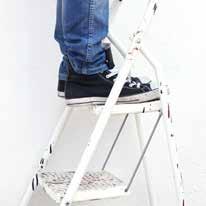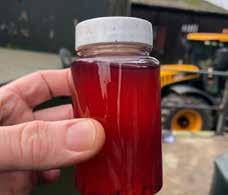
9 minute read
EXPERTS Advice on marketing, safety and selling aged stock
HSE updates advice after 35 ladder deaths in a year
The HSE has recently issued a safety bulletin offering guidance on how, when and where to use ladders and stepladders. Is this good news for your business?
Advertisement
Why the concern?
2021/22 HSE statistics show there were 35 fatal injuries and 39,376 non-fatal injuries caused by falling from height.
There is an urban myth that ladders of all types are “banned” from the workplace. This is not the case. If they are used sensibly, they can be an
SAFETY appropriate piece of work equipment.
PAUL MARSH
Office manager SafetyAide
What’s the updated advice?
The HSE has recognised the danger that incorrect ladder use presents and has updated its guidance to offer a sensible, balanced approach to using ladders. ‘LA455 Safe Use of Ladders and Stepladders – a brief guide’ is the new guidance jointly produced by the Ladder Association and the HSE. It highlights the importance of training and offers expanded guidance on different types of portable ladder, such as telescopic and combination (or multi-purpose) ladders.
Managing ladder use
If you are purchasing ladders, the standards have also recently been updated to improve their safety. Class 1 and Class 3 ladders are no longer available to buy. However, if you own such ladders they may still be used. All ladders should now be designed and manufactured to the current EN 131 standard. Simple measures to use ladders safely include: l Use for short tasks only, generally less than half an hour. If over this timeframe other lifting equipment such as scaffolding should be used. l Select the correct ladder for the task. l Users must be trained in how to assess the risks of using a ladder, when it is right to use one (or not), which type and how to use it. l All ladders, whatever type, should be safety checked before each use and removed from use if damaged. Tip. Use the new guidance along with our document to avoid getting bogged down with overly complicated control measures for working at height.
Using software to help sell aged parts
DEALERSHIPS OFTEN HAVE to wrestle with their unsold inventory to clear space for new products, a problem that can become difficult to solve without help. There are only so many places you can sell your old stock, especially as a local business with a limited pool of customers.
The more money and time you waste trying to move old parts and outdated tools, the harder it becomes to recover once you finally have room for fresh stock. In some cases, this can be a silent business-killer, something that can only be stopped if you prepare in advance.
Buying old stock
Stock gridlock
Having aged and unsold products taking up storage space in your dealership creates some very irritating problems. Even if you can pile all of those parts and components onto a single shelf, that’s one less shelf you can use for new, high-demand stock that will actually make money: you are bottlenecking your own profits.
Of course, for many dealerships, simply throwing away these unsold parts isn’t an option. After sinking thousands of pounds into stockpiling your storage room, it’s hard to justify losing that money when there’s still a chance that it could turn a profit with the right audience.
For many businesses, especially smaller ones, this creates a form of gridlock where either option involves losing money. If you have extremely tight profit margins or haven’t been operating for very long, then it could only take a single mistake to put your business at serious risk of failure.
Reselling old stock
One of the biggest problems with unsold stock and obsolete parts is that a market for them does exist – but it’s just hard to identify customers’ needs for this type of stock. It’s easy to identify an audience for some old dealership stock that’s two years out of date, but it’s hard to actually market towards them without putting yourself in an even bigger financial deficit. The problem isn’t that
older products are worthless, but that they’re only worth a lot to the right people. Finding those people is hard, and getting them to buy from your dealership can be even harder, which often makes it tempting to just write off your old parts and sell them for scrap. It helps to flip your perspective on the situation. You may have situations where you need older parts, or scenarios where buying another dealership’s aged stock allowed you to fulfil an important service job at the last minute. In most cases like this, the hardest part wasn’t recognising that you needed these parts – it was finding a platform where you could purchase them. The biggest issue with aged inventory is displaying it in a place where the right audiences can see it. These aren’t always going to MARKETING be your normal customers, and JORDAN in many cases, they will be other STOVOLD dealerships looking for emergenIbcos Strategic Business Development Analyst cy solutions to a lack of important components. But what kind of platform can actually resolve this problem?
Solving the gridlock
The Ibcos Gold Parts Marketplace provides a business-tobusiness solution for buying and selling aged parts inventory, running on software that makes it incredibly easy for a dealership to display and sell their old stock. With features like stock filtering, easy price setting and reliable in-platform marketing options, Gold Parts Marketplace has essentially become a new dealer-to-dealer storefront for discounted stock. While it might still be in its infancy, it will be an excellent way for businesses to offload old parts that they can’t find another profitable use for. Free advertising and no-commission purchasing have made it a very accessible option to dealerships that need some aged parts, with sellers only paying a small commission fee.
If you want to know more about how Gold Parts Marketplace operates and how to list your own stock on the platform, go to www.customer.ibcos.co.uk/gold-partsmarketplace or send an email to sales@ ibcos.co.uk
Fuel theft is a major problem now, and it’s only going to get worse
INCREASES IN FUEL costs plus the changes to the red diesel legislation are creating the perfect storm. As of April 1, it became illegal for many industries to use red diesel. This includes commercial operations (including private healthcare sites), construction and plant hire and other heavy industry.
Farms are exempt from this change, meaning they can still benefit from the reduced duty on red diesel.
Unfortunately, the inability to purchase red diesel legally has resulted in an increase in fuel thefts from those who can still legally store and use it.
This, plus the huge increase in household fuel prices, is creating the incentive to get fuel from other sources.
Farms are prime targets for thieves
It is common knowledge that agricultural sites have fuel storage tanks, often unprotected, exposed and isolated. Unfortunately, because of this, farms are being identified as prime targets for fuel thieves.
If the tanks are drained, productivity on the farm has to take a hit. Farmers can’t run their equipment on empty tanks. But there’s another potential impact of fuel theft.
When the tank is compromised by fuel thieves, it also leaves it vulnerable to contamination. Tanks that are in some way left open, whether it be through drilled holes or the fill point can let in solid particulates as well as water. If farmers are unaware of damage to their tank and fuel theft is very gradual and undetectable, they could be filling their expensive equipment with contaminated fuel which can cause monumental damage with huge financial implications. The general advice is for farmers to invest in security as a precaution but also to deter thieves who might try their luck.
Next-level protection
Any business storing fuel on-site must have a Fuel Theft Detection System – it’s no longer an option. CCTV cameras and motion sensor lighting alone no longer cut it.
Official advice on increasing fuel tank security, published by NFU Mutual, suggests the following methods for upping protection: l To record the location of tanks, when they were last filled, and their current level and then to regularly check levels; l To fit a fuel tank alarm, which sets off an audible or remotely monitored alarm in a number of situations including when the fuel level suddenly drops in the tank, or if it drops beloa defined level.
IPU has developed a Fuel Theft Detection System in direct response to the increase in thefts
FUEL CLIVE CARTER
Sales Executive at IPU Group seen by its customers. It will: l Immediately alert you if fuel levels drop dramatically; l Alert you if fuel levels are dropping unexpectedly; l Alert you if the liquid in the tank is no longer diesel. (As a way to get around fuel level detection systems, diesel can be replaced with water or other liquids, which would cause immeasurable damage to equipment.)
Alert you if your fuel system is being tampered with, in an attempt to bypass it. (Some thieves will drill holes in the side of tanks to directly syphon it off.)

Visit www.ipu.co.uk/bagma or call IPU on 0121 5110400 to learn more about how IPU can help protect the fuel that powers your customers’ farms.
Keep on communicating
ARE YOU CONSISTENT with your communication? Are you showing up where your customers are looking? Are you reminding them that you are there?
Just because they have purchased from you before and you provided an amazing service, it doesn’t mean they will remain loyal! Our marketplace is becoming increasingly competitive and buying decisions have shifted from brand loyalty to being heavily focussed on price. Therefore, you must keep talking to them, keep showing up, keep reminding them who you are and what you have to offer them.
One way to consistently show up is in their mailbox. When it comes to email marketing, a lot of people are put off due to the GDPR issues. It is important that you firstly touch base with your customers to ensure they are happy to be contacted but it really will be worth it to be able to utilise this marketing channel. You must also always ensure you include an opt-out option on any marketing communication that you do send after they have stated their consent.
My top tips for email marketing
Commit to a frequency of how often you want to show up, bi-weekly, once a month or once a quarter. It is your choice. But make sure that you deliver consistently, do not over commit and run the risk of giving up just a few months in.
Ensure that your email design is consistent too by using the correct brand fonts, colour
palette and logos. The customer should be able to tell it’s your company before they even scroll down the email. MARKETING You are now ready to input the content MARY PERRY on your email. Try to keep it short and sweet, Owner focus on one or two key points otherwise the ME Marketing and Events reader won’t scroll and might lose interest. And remember, email marketing is not all about the sell! This is also a great opportunity to notify your audience of upcoming shows and events, new team members and even some company news. Don’t make them hit that ‘unsubscribe’ button. A fantastic free platform to get you started is Mailchimp, but there are also some great website integrated systems too, so speak with your web developers and see what they can offer. And remember, if you need assistance with your email marketing, get in touch with me.








